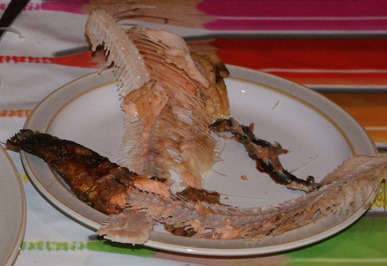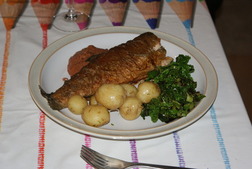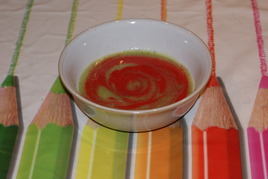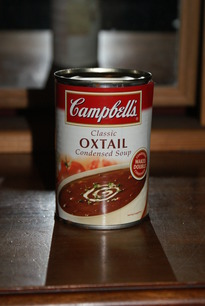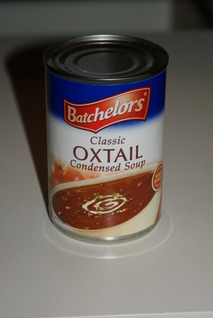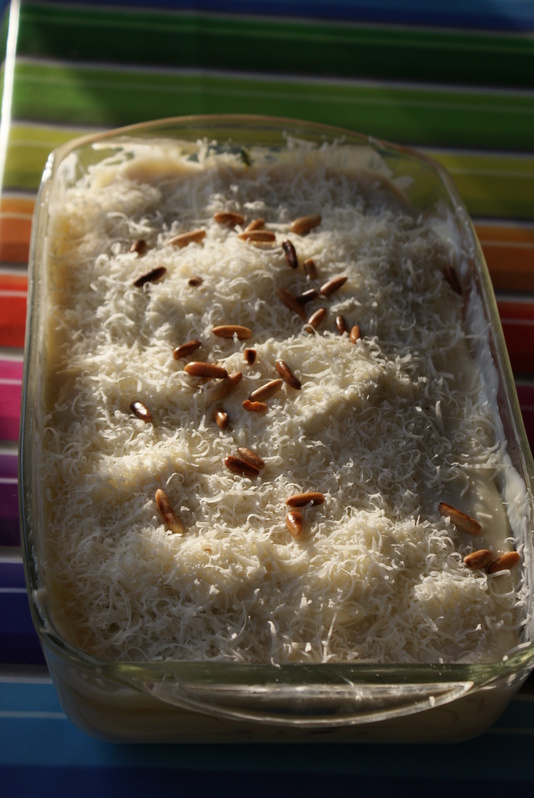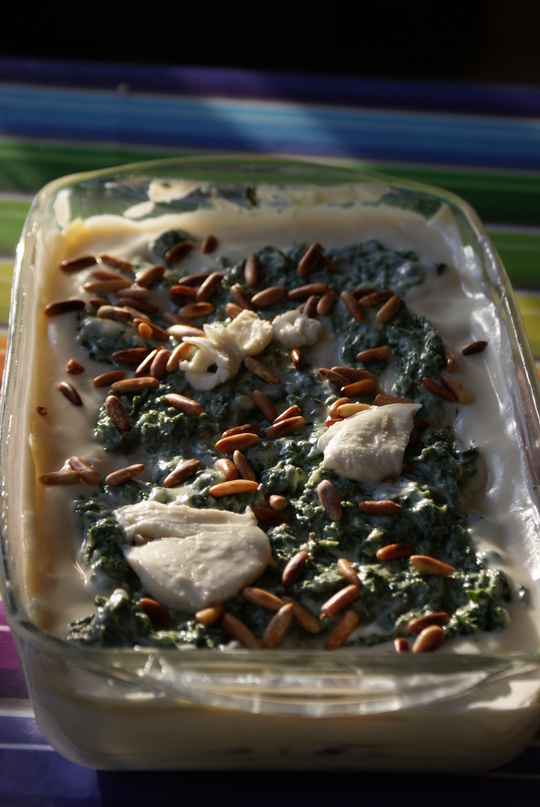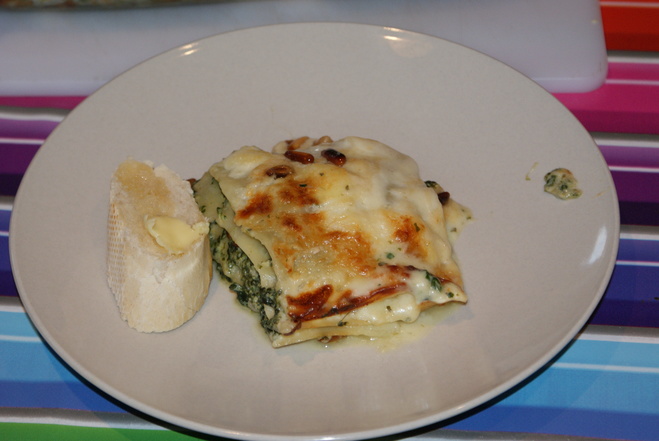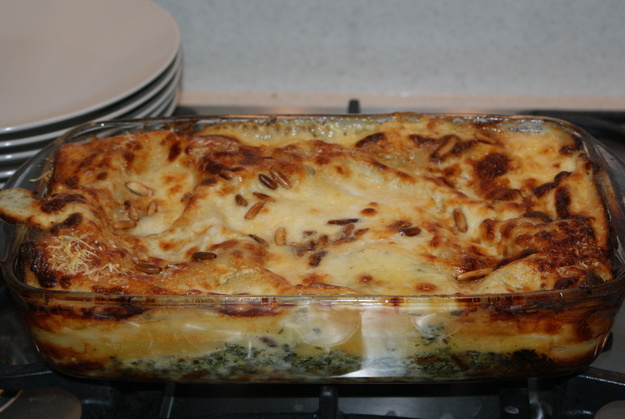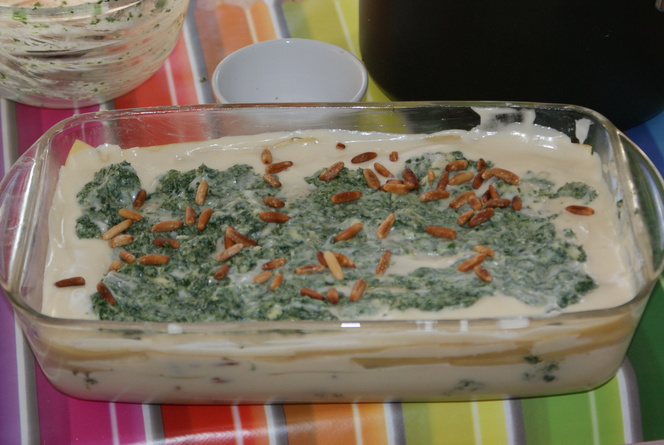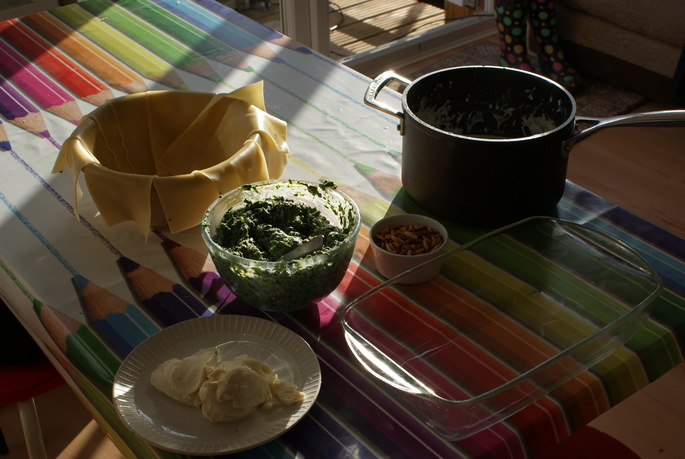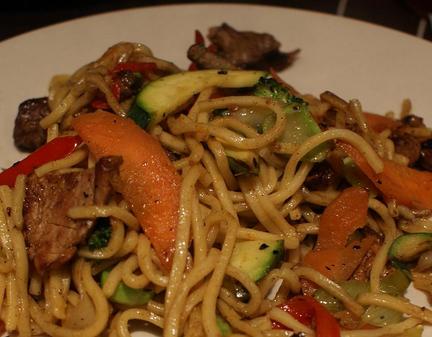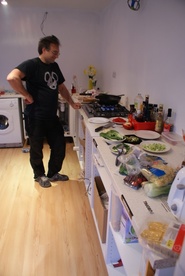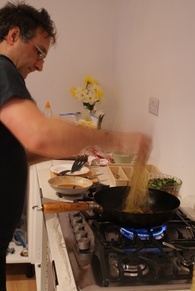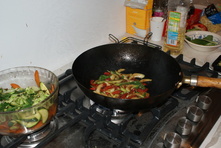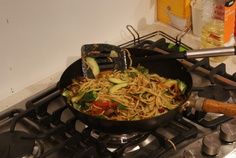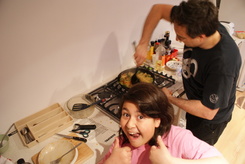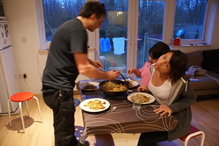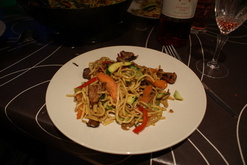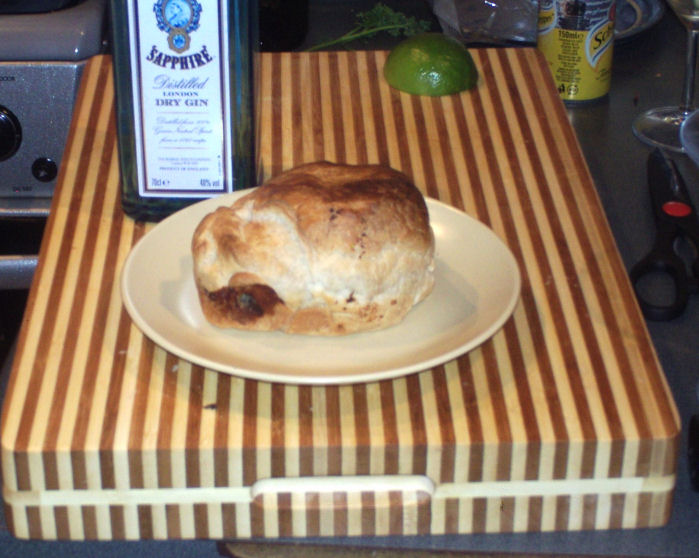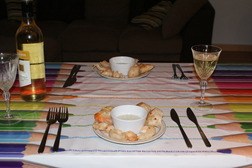
Back In The Fold
Of course, we made up again shortly afterwards.
Just our bi-annual wobble I guess.
Still, I've been starting to feel antsy about not having anyone to cook for during our break (including myself due to my (failing) attempts to lose weight by eating just salads),
so when Rachel texted me to say that she'd not had a decent meal for ages, was sick of living on sausages and fancied a nice bit of fish, and Sunday sailing at the East Coast Sailing Week Regatta was cancelled due to the arrival of Armaggedon (I believe that's a 13 on the Beaufort scale), it seemed a God-given opportunity to shop like a maniac and pop around to satisfy poor Rachel's desires.
Obviously the choice (and quality) of fish was somewhat limited due to it being a Sunday, and there being nowhere to shop but supermarkets (sigh), but I did my best.
I have to say, though, you can't beat leftover old supermarket fishes for price!
Just our bi-annual wobble I guess.
Still, I've been starting to feel antsy about not having anyone to cook for during our break (including myself due to my (failing) attempts to lose weight by eating just salads),
so when Rachel texted me to say that she'd not had a decent meal for ages, was sick of living on sausages and fancied a nice bit of fish, and Sunday sailing at the East Coast Sailing Week Regatta was cancelled due to the arrival of Armaggedon (I believe that's a 13 on the Beaufort scale), it seemed a God-given opportunity to shop like a maniac and pop around to satisfy poor Rachel's desires.
Obviously the choice (and quality) of fish was somewhat limited due to it being a Sunday, and there being nowhere to shop but supermarkets (sigh), but I did my best.
I have to say, though, you can't beat leftover old supermarket fishes for price!
Prawn And Scallop Tempura
starter fish
Serves 2
Ingredients
8 fresh peeled King Prawns
6 scallops
tempura batter no. 6
flour for coating
groundnut oil for deep-frying
cup mayonnaise
lemon juice
large hanful mint leaves
2-3 Tablespoons creme fraiche
Method
6 scallops
tempura batter no. 6
flour for coating
groundnut oil for deep-frying
cup mayonnaise
lemon juice
large hanful mint leaves
2-3 Tablespoons creme fraiche
Whizz up the mint leaves with the mayonnaise using a hand blender or a small food processor.
Moisten with a little lemon or lime juice to get things going if you like.
You need quite a lot of mint leaves to get a good flavour.
Stir in the creme fraiche to give a little sharpness to taste.
Dollop the dip into individual ramekins and set aside in the fridge to chill.
Heat the heavy pot of groundnut oil. When it is hot enough a drop of batter will fizz enthusiastically and rise to the surface. Roll each ingredient in the flour to coat, then dip in the batter and drop into the oil. You can add half a dozen pieces at a time, but don't overload the pan, and keep the oil up to temperature. When the pieces are done they will rise to the top and take on a little colour. Scoop them out with a slotted spoon and set aside to drain on paper towels.
When all the pieces are cooked, put a ramekin of dip in the middle of a plate, surround with the tempura, and serve.
Stir in the creme fraiche to give a little sharpness to taste.
Dollop the dip into individual ramekins and set aside in the fridge to chill.
Heat the heavy pot of groundnut oil. When it is hot enough a drop of batter will fizz enthusiastically and rise to the surface. Roll each ingredient in the flour to coat, then dip in the batter and drop into the oil. You can add half a dozen pieces at a time, but don't overload the pan, and keep the oil up to temperature. When the pieces are done they will rise to the top and take on a little colour. Scoop them out with a slotted spoon and set aside to drain on paper towels.
When all the pieces are cooked, put a ramekin of dip in the middle of a plate, surround with the tempura, and serve.
Yum!
Pan-Fried Rainbow Trout with Rhubarb Relish
main side fish
Serves 2
Ingredients
2 nice fat Rainbow Trout
knob of butter
seasoned flour
1 portion of Rhubarb and Mustard Relish (with strawberries)
1lb new potatoes
grated peel of 1 lime
few mint stalks
1lb curly kale, shredded
6 spring onions, diagonally sliced
1 teaspoon yellow mustard seeds
1 teaspoon black onion seeds
Method
knob of butter
seasoned flour
1 portion of Rhubarb and Mustard Relish (with strawberries)
1lb new potatoes
grated peel of 1 lime
few mint stalks
1lb curly kale, shredded
6 spring onions, diagonally sliced
1 teaspoon yellow mustard seeds
1 teaspoon black onion seeds
Start your Rhubarb Relish
Add some of your strawberries for an extra summery zing.
Clean the trout, removing their gills and their head (unless you like them staring at you with their soulless milky eyes) and pat dry on kitchen paper.
Season some plain flour with salt, mixed ground peppercorns and a dash of paprika on a large plate.
Bring a large pot of salted water to boil and throw in the mint stalks and new potatoes.
Heat a large frying pan and a wok.
Roll the fish around in the plate of flour to get a good coating. Add enough butter to coat the bottom of the frying pan and add the fish. You want the pan hot enough to quickly fire off any water from the fish so they keep frying and to brown the butter giving a nice nutty flavour, but not so hot that you burn the butter and turn it bitter.
Cook the fish for about 5 minutes on each side so that the flesh in the centre turns opaque and firms up, but don't dry it out.
It takes a reasonably long time to do this, ideally you will end up with a lovely crunchy, tasty bit of well-browned skin, and moist succulent flesh that forks beautifully off the bone. If the flesh looks pale or translucent and tastes gelatinous it is undercooked, and if it seems dry and claggy then it is overdone.
Meanwhile pour a coating of olive or peanut oil into the wok, when it reaches smoking point throw in the onion and the mustard seeds. Have a lid ready to just cover the wok to keep the seeds in and wait until they start to pop.
Then throw in the spring onions, shake the wok once or twice then throw in the kale, maybe in two or three batches to keep the wok going.
Scoop into a serving dish when the kale is cooked through, or beginning to crisp at the edges. Feel free to moisten with a little lime juice if you fancy.
Drain the potatoes and dress with a knob of butter, the grated lime peel and some shredded mint leaves if you like.
Clean the trout, removing their gills and their head (unless you like them staring at you with their soulless milky eyes) and pat dry on kitchen paper.
Season some plain flour with salt, mixed ground peppercorns and a dash of paprika on a large plate.
Bring a large pot of salted water to boil and throw in the mint stalks and new potatoes.
Heat a large frying pan and a wok.
Roll the fish around in the plate of flour to get a good coating. Add enough butter to coat the bottom of the frying pan and add the fish. You want the pan hot enough to quickly fire off any water from the fish so they keep frying and to brown the butter giving a nice nutty flavour, but not so hot that you burn the butter and turn it bitter.
Cook the fish for about 5 minutes on each side so that the flesh in the centre turns opaque and firms up, but don't dry it out.
It takes a reasonably long time to do this, ideally you will end up with a lovely crunchy, tasty bit of well-browned skin, and moist succulent flesh that forks beautifully off the bone. If the flesh looks pale or translucent and tastes gelatinous it is undercooked, and if it seems dry and claggy then it is overdone.
Meanwhile pour a coating of olive or peanut oil into the wok, when it reaches smoking point throw in the onion and the mustard seeds. Have a lid ready to just cover the wok to keep the seeds in and wait until they start to pop.
Then throw in the spring onions, shake the wok once or twice then throw in the kale, maybe in two or three batches to keep the wok going.
Scoop into a serving dish when the kale is cooked through, or beginning to crisp at the edges. Feel free to moisten with a little lime juice if you fancy.
Drain the potatoes and dress with a knob of butter, the grated lime peel and some shredded mint leaves if you like.
The Rhubarb relish goes beautifully with the fish!
Serve the relish in a pot on the side - I think that would look better than trying to artistically dollop it on the plate.
The curly kale was nice enough - but didn't quite go with the fish. Also I slightly overcooked the onions by letting them fry through before adding the kale - so only give them a brief shake in the pan.
I found a recipe for broadbean mash that might have been a better choice, except that I already had the mushy rhubarb relish. Perhaps some kind of whole broadbean dish would have been better?
Serve the relish in a pot on the side - I think that would look better than trying to artistically dollop it on the plate.
The curly kale was nice enough - but didn't quite go with the fish. Also I slightly overcooked the onions by letting them fry through before adding the kale - so only give them a brief shake in the pan.
I found a recipe for broadbean mash that might have been a better choice, except that I already had the mushy rhubarb relish. Perhaps some kind of whole broadbean dish would have been better?
Chilled Strawberry And Melon Soup
soup
Makes 4 delicate portions
Ingredients
1 lb /400g strawberries
½ Galia melon
juice of 1 lime
handful mint leaves
ground mixed peppercorns
pinch salt
Method
½ Galia melon
juice of 1 lime
handful mint leaves
ground mixed peppercorns
pinch salt
Core the strawberries and whizz them up in a food processor.
You can add a little water or cranberry juice to get things going if necessary.
Add a little sugar if the strawberries are not sweet enough, though I didn't need to. My strawberries were absolutely gorgeous :) Push through a sieve into a jug, add a pinch of salt and a grinding of mixed red/green/black peppercorns then cover and put in the fridge to chill.
Serve by pouring equal quantites of the purées into opposite sides of a bowl and swirling with a knife to make pretty patterns.
Add a little sugar if the strawberries are not sweet enough, though I didn't need to. My strawberries were absolutely gorgeous :) Push through a sieve into a jug, add a pinch of salt and a grinding of mixed red/green/black peppercorns then cover and put in the fridge to chill.
I did try to get rid of the (tiny) strawberry seeds completely by straining through muslin,
but the strawberry mush was just too thick to pass through even a single layer.
Cut the half melon into slices, deseed and peel them,
chop them into pieces and whizz them up in a food processor with the lime juice and the mint leaves.
Pour this out into another jug, cover and chill in the fridge.
Again, if the melon is not quite sweet enough you could add a little sugar, but I didn't need to.
You are aiming to produce the same quantities of strawberry and melon purées
You are aiming to produce the same quantities of strawberry and melon purées
Serve by pouring equal quantites of the purées into opposite sides of a bowl and swirling with a knife to make pretty patterns.
Delicious soup, which we had as a dessert.
Rachel commented that the purées would make lovely sorbets too.
Rachel commented that the purées would make lovely sorbets too.
The End Of The Line?
Ah those Campbell soup cans.
The inspiration of artists, the darling of gourmandes and the kindler of fond childhood memories.
Requiescat in pace
As a boy, I spent many weekends, and long summer weeks with a small band of close friends (who I no longer talk to) hiking off into that vast wilderness - The Yorkshire Dales. Armed only with tins of Campbell's Condensed Oxtail Soup, feet-long paper packets of dried spaghetti, fresh mince, onions, garlic, mushrooms, various small plastic film containers (remember those?) filled with dried oregano, Worcestershire and Tabasco sauce, and of course the fresh eggs and bacon for breakfast, we would muscle our enormous rucksacks over hills and dales to comfy camping spots by rivers and streams. And pubs.
Once settled in with our tents up and sleeping bags decompressing we would pump up the solid brass paraffin stoves, break out the giant pasta pan and start boiling the water for our time-honoured Spaghetti Bolognese di Campeggio
I don't know where our traditional family recipe for oxtail-soup-based Spaghetti Bolognese originally came from, I'm not even sure it was from my family (though there is a history of condensed-soup-based cookery), but I can't smell the rich meaty aroma of hot, bubbling condensed oxtail soup without being instantly transported back to those childhood trips.
Imagine my horror, then, at the double body blows of first being denied oxtail soup due to our Gubbermint's hysterical overreaction to the fear of Mad Cow Disease (I don't know if you tried the oxtail-effect soup produced by Campbell during this period but suffice to say - you really can't make a convincing oxtail out of carrots), and then to the sale of Campbell's Soup (UK) label to Batchelors.
Sold.
A Goddamn cultural icon!
Naturally as soon as I heard the news in 2006 and fearing that I might never get to taste that glorious meaty phlegm again, I stocked up with soup tins as for a nuclear war. Fortunately for my sanity, though, it seems that Batchelor's are still making the same recipe and their new cans are quite acceptable. If not as photogenic.
Fast forward to 2010, and down to my last can of Campbell's original, possibly the last can in the country, I decide to share this priceless hoarded treasure together with its golden childhood memories with my girlfriend on a well-earned camping holiday. This time out in the vast wilderness of the Cairngorms.
Unfortunately for our relationship I happened to notice that the expiration date on the can was 2008, and had to open my big mouth, at which Rachel immediately refused to have anything more to do with it, demanding that a tin of tomatoes be substituted instead.
Sacrilege!
This despite being perfectly happy to munch her way through a fridge-full of tragically mouldering produce at home, smugly proclaiming how it helps to keep up her immunities.
So I immediately dumped her.
Pretty fair I thought.
I print the recipe here for anyone else who fancies recreating this special experience.
The food that is. Not breaking up with your girlfriend.
You don't need my help with that!
The inspiration of artists, the darling of gourmandes and the kindler of fond childhood memories.
Requiescat in pace
As a boy, I spent many weekends, and long summer weeks with a small band of close friends (who I no longer talk to) hiking off into that vast wilderness - The Yorkshire Dales. Armed only with tins of Campbell's Condensed Oxtail Soup, feet-long paper packets of dried spaghetti, fresh mince, onions, garlic, mushrooms, various small plastic film containers (remember those?) filled with dried oregano, Worcestershire and Tabasco sauce, and of course the fresh eggs and bacon for breakfast, we would muscle our enormous rucksacks over hills and dales to comfy camping spots by rivers and streams. And pubs.
Once settled in with our tents up and sleeping bags decompressing we would pump up the solid brass paraffin stoves, break out the giant pasta pan and start boiling the water for our time-honoured Spaghetti Bolognese di Campeggio
I don't know where our traditional family recipe for oxtail-soup-based Spaghetti Bolognese originally came from, I'm not even sure it was from my family (though there is a history of condensed-soup-based cookery), but I can't smell the rich meaty aroma of hot, bubbling condensed oxtail soup without being instantly transported back to those childhood trips.
Imagine my horror, then, at the double body blows of first being denied oxtail soup due to our Gubbermint's hysterical overreaction to the fear of Mad Cow Disease (I don't know if you tried the oxtail-effect soup produced by Campbell during this period but suffice to say - you really can't make a convincing oxtail out of carrots), and then to the sale of Campbell's Soup (UK) label to Batchelors.
Sold.
A Goddamn cultural icon!
Naturally as soon as I heard the news in 2006 and fearing that I might never get to taste that glorious meaty phlegm again, I stocked up with soup tins as for a nuclear war. Fortunately for my sanity, though, it seems that Batchelor's are still making the same recipe and their new cans are quite acceptable. If not as photogenic.
Fast forward to 2010, and down to my last can of Campbell's original, possibly the last can in the country, I decide to share this priceless hoarded treasure together with its golden childhood memories with my girlfriend on a well-earned camping holiday. This time out in the vast wilderness of the Cairngorms.
Unfortunately for our relationship I happened to notice that the expiration date on the can was 2008, and had to open my big mouth, at which Rachel immediately refused to have anything more to do with it, demanding that a tin of tomatoes be substituted instead.
Sacrilege!
This despite being perfectly happy to munch her way through a fridge-full of tragically mouldering produce at home, smugly proclaiming how it helps to keep up her immunities.
So I immediately dumped her.
Pretty fair I thought.
I print the recipe here for anyone else who fancies recreating this special experience.
The food that is. Not breaking up with your girlfriend.
You don't need my help with that!
Feeds an army
Spaghetti Bolognese di Campeggio
main meat pasta
Ingredients- 2 fist-fulls spaghetti
- 2lb beef mince
- 6 cloves garlic, minced
- 2 onions, finely chopped
- 2 cans Campbell's Condensed Oxtail Soup (or to taste)
- dried oregano
- dozen button mushrooms, quartered
- Worcestershire Sauce
- Tabasco Sauce
Optional:- bacon, chopped
- chorizo, chopped
- yoghurt
First hike out into the Yorkshire Dales carrying ten times the amount of clothing and food that you could possibly require.
Set up camp in a lonely spot near to running water, but within pitch-dark walking distance of a Theakston Pub.
Cover the bottom of a large pan with olive oil and fry the mince until it starts to brown (chopped bacon or chorizo works as a delicious addition also), toss in the minced garlic and crisp it a little, then add the onion.
At this point throw on the dried oregano and fry until the onions turn glassy.
Add quartered mushrooms.
Meanwhile boil a large pot of water for the spaghetti. Dump the spaghetti in the boiling water and cook until just al dente, then strain.
While the spaghetti cooks pour the cans of condensed oxtail soup over the fried mince. and let the sauce gently simmer.
Flavour to taste with Tabasco and Worcestershire sauce.
Serve the spaghetti with the sauce poured over.
Wash the dishes*.
Go to the pub.
Set up camp in a lonely spot near to running water, but within pitch-dark walking distance of a Theakston Pub.
Cover the bottom of a large pan with olive oil and fry the mince until it starts to brown (chopped bacon or chorizo works as a delicious addition also), toss in the minced garlic and crisp it a little, then add the onion.
At this point throw on the dried oregano and fry until the onions turn glassy.
Add quartered mushrooms.
Meanwhile boil a large pot of water for the spaghetti. Dump the spaghetti in the boiling water and cook until just al dente, then strain.
While the spaghetti cooks pour the cans of condensed oxtail soup over the fried mince. and let the sauce gently simmer.
I found a single tin of soup will do for 2lb mince if your stocks are running low.
If you want to be a bit more philistine traditional you could also add tinned tomatoes
It's ready when a layer of luminous orange oil floats greasily over the surface.If you want to be a bit more philistine traditional you could also add tinned tomatoes
Flavour to taste with Tabasco and Worcestershire sauce.
Serve the spaghetti with the sauce poured over.
You won't need grated cheese, but yoghurt is a nice topping.
Eat.Wash the dishes*.
Go to the pub.
*There's little to recommend standing in a freezing cold stream desperately scraping at the thick residue of heavy orange fat
coating your pans and plates when you've forgotten to bring the washing up liquid, but you would be well-advised to do so.
As delightful as the enticing aroma of hot condensed oxtails can be the evening before, it is a nauseatingly cloying stench to first greet your hangover next morning.
As delightful as the enticing aroma of hot condensed oxtails can be the evening before, it is a nauseatingly cloying stench to first greet your hangover next morning.
The Long Spinach Friday
Because I'm trying to incorporate spinach and samphire into
my ideas for a lemon risotto-stuffed squid dinner,
this turned into a very spinach-oriented weekend! Starting with samphire and spinach, followed by samphire and spinach puree,
then on to spinach soufflés, spinach crisps, then finally spinach oil.
We rounded off with a pretty enjoyable Spinach Lasagne from Delia Smith for light relief.
We rounded off with a pretty enjoyable Spinach Lasagne from Delia Smith for light relief.
Spinach and Ricotta Lasagne with Pine Nuts
main pasta veg cheese
Serves 6
Ingredients
For the sauce:
1½ pints (850 ml) milk, or less
2 oz (50 g) butter
2 oz (50 g) plain flour
1 bay leaf
2½ oz (60 g) Parmesan (Parmigiano Reggiano)
salt and freshly milled black pepper
For the lasagne:
1 lb 5 oz (600 g) young leaf spinach
8 oz (225 g) ricotta
12 fresh lasagne sheets (weighing about 9 oz/250 g)
2 oz (50 g) pine nuts
knob of butter
¼ whole nutmeg, grated
7 oz (200 g) Gorgonzola, Shropshire Blue or Cashel Blue cheese, crumbled
7 oz (200 g) Mozzarella, coarsely grated
salt and freshly milled black pepper
Method
1½ pints (850 ml) milk, or less
2 oz (50 g) butter
2 oz (50 g) plain flour
1 bay leaf
2½ oz (60 g) Parmesan (Parmigiano Reggiano)
salt and freshly milled black pepper
For the lasagne:
1 lb 5 oz (600 g) young leaf spinach
8 oz (225 g) ricotta
12 fresh lasagne sheets (weighing about 9 oz/250 g)
2 oz (50 g) pine nuts
knob of butter
¼ whole nutmeg, grated
7 oz (200 g) Gorgonzola, Shropshire Blue or Cashel Blue cheese, crumbled
7 oz (200 g) Mozzarella, coarsely grated
salt and freshly milled black pepper
Pre-heat the oven to gas mark 4, 350°F (180°C).
Par-boil the lasagne sheets (yes, even the pre-cooked ones) in salted oiled water - about half the time recommended for cooking them, or 3-4 minutes - then drain the sheets and plunge into cold water. Carefully separate them and lay them out to one side hanging from a rack or sides of a pan or colander.
Now make the sauce, which can be done using the all-in-one method. This means placing the milk, butter, flour and bay leaf together in a saucepan, giving it a good seasoning, then, over a medium heat, whisking the whole lot together continually until it comes to simmering point and has thickened. Now turn the heat down to its lowest possible setting and allow the sauce to cook gently for 5 minutes.
After that, stir in 2 oz (50 g) of the Parmesan, then remove it from the heat, discard the bay leaf and place some clingfilm over the surface to prevent a skin from forming. This really works - you only need to put the cling film across the top of the pan too Now you need to deal with the spinach. First of all remove and discard the stalks, then wash the leaves really thoroughly in 2 or 3 changes of cold water and shake them dry. Next, take your largest saucepan, pop the knob of butter in it, then pile the spinach leaves in on top, sprinkling them with a little salt as you go. Now place the pan over a medium heat, put a lid on and cook the spinach for about 2 minutes, turning the leaves over halfway through. After that, the leaves will have collapsed down and become tender.
Next drain the spinach in a colander and, when it's cool enough to handle, squeeze it in your hands to get rid of every last drop of liquid. Then place it on a chopping board and chop it finely. Now put it into a bowl, add the ricotta, then approximately 5 fl oz (150 ml) of the sauce. Give it a good seasoning of salt and pepper and add the grated nutmeg. Then mix everything together really thoroughly and, finally, fold in the crumbled Gorgonzola. Now you need to place a small frying pan over a medium heat, add the pine nuts and dry-fry them for about 1 minute, tossing them around to get them nicely toasted but being careful that they don't burn. Then remove the pan from the heat and assemble the lasagne.
To do this, spread a quarter of the sauce into the bottom of the dish and, on top of that, a third of the spinach mixture, followed by a scattering of toasted pine nuts. Now place sheets of pasta on top of this - you may need to tear some of them in half with your hands to make them fit. Now repeat the whole process, this time adding a third of the grated Mozzarella along with the pine nuts, then the lasagne sheets. Repeat again, finishing with a layer of pasta, the rest of the sauce and the remaining Parmesan and Mozzarella. When you are ready to cook the lasagne, place it on the middle shelf of the pre-heated oven and bake for 50-60 minutes, until the top is golden and bubbling. Then remove it from the oven and let it settle for about 10 minutes before serving.
Par-boil the lasagne sheets (yes, even the pre-cooked ones) in salted oiled water - about half the time recommended for cooking them, or 3-4 minutes - then drain the sheets and plunge into cold water. Carefully separate them and lay them out to one side hanging from a rack or sides of a pan or colander.
Now make the sauce, which can be done using the all-in-one method. This means placing the milk, butter, flour and bay leaf together in a saucepan, giving it a good seasoning, then, over a medium heat, whisking the whole lot together continually until it comes to simmering point and has thickened. Now turn the heat down to its lowest possible setting and allow the sauce to cook gently for 5 minutes.
Or you could make the sauce properly as I did!
After that, stir in 2 oz (50 g) of the Parmesan, then remove it from the heat, discard the bay leaf and place some clingfilm over the surface to prevent a skin from forming. This really works - you only need to put the cling film across the top of the pan too Now you need to deal with the spinach. First of all remove and discard the stalks, then wash the leaves really thoroughly in 2 or 3 changes of cold water and shake them dry. Next, take your largest saucepan, pop the knob of butter in it, then pile the spinach leaves in on top, sprinkling them with a little salt as you go. Now place the pan over a medium heat, put a lid on and cook the spinach for about 2 minutes, turning the leaves over halfway through. After that, the leaves will have collapsed down and become tender.
Next drain the spinach in a colander and, when it's cool enough to handle, squeeze it in your hands to get rid of every last drop of liquid. Then place it on a chopping board and chop it finely. Now put it into a bowl, add the ricotta, then approximately 5 fl oz (150 ml) of the sauce. Give it a good seasoning of salt and pepper and add the grated nutmeg. Then mix everything together really thoroughly and, finally, fold in the crumbled Gorgonzola. Now you need to place a small frying pan over a medium heat, add the pine nuts and dry-fry them for about 1 minute, tossing them around to get them nicely toasted but being careful that they don't burn. Then remove the pan from the heat and assemble the lasagne.
To do this, spread a quarter of the sauce into the bottom of the dish and, on top of that, a third of the spinach mixture, followed by a scattering of toasted pine nuts. Now place sheets of pasta on top of this - you may need to tear some of them in half with your hands to make them fit. Now repeat the whole process, this time adding a third of the grated Mozzarella along with the pine nuts, then the lasagne sheets. Repeat again, finishing with a layer of pasta, the rest of the sauce and the remaining Parmesan and Mozzarella. When you are ready to cook the lasagne, place it on the middle shelf of the pre-heated oven and bake for 50-60 minutes, until the top is golden and bubbling. Then remove it from the oven and let it settle for about 10 minutes before serving.
This went down pretty well with everyone, despite complaints that the pine nuts reminded them too much of maggots.
Goes nicely with a salad and freshly baked french bread. Personally I'm a big fan of lasagne or macaroni cheese with chips, but then I too have philistine tendencies.
Goes nicely with a salad and freshly baked french bread. Personally I'm a big fan of lasagne or macaroni cheese with chips, but then I too have philistine tendencies.
Tagliatelle Carbonara For Philistines
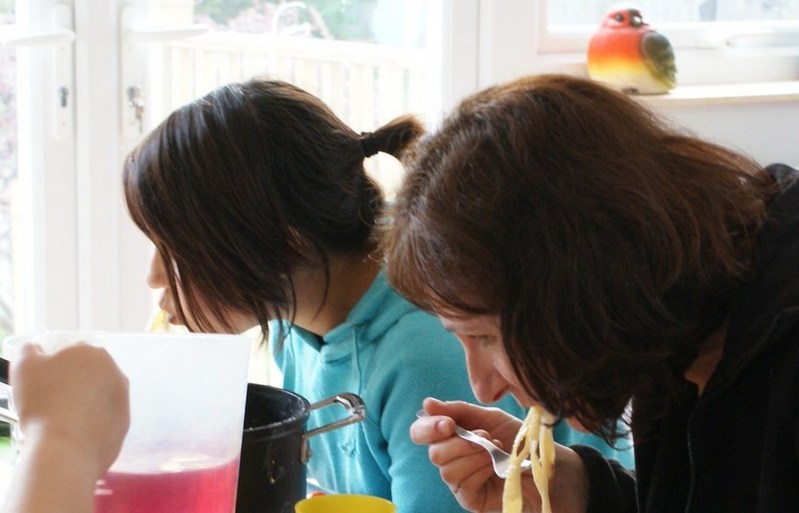
After a tough but satisfying May Day bank holiday babysitting the girlies,
this was their choice of dinner - and I must admit it went down a storm.
Ready in bare minutes (well O.K. an hour, but it was the first time we made it and Georgina did all the work), and chock full of creamy Philadelphian goodness - their busily masticating little faces say it all really.
Ready in bare minutes (well O.K. an hour, but it was the first time we made it and Georgina did all the work), and chock full of creamy Philadelphian goodness - their busily masticating little faces say it all really.
Ideal for philistines,
this comes with a BIG Georgina seal of approval!
this comes with a BIG Georgina seal of approval!
Tagliatelle Carbonara with Philadelphia Cream Cheese
main pasta cheese
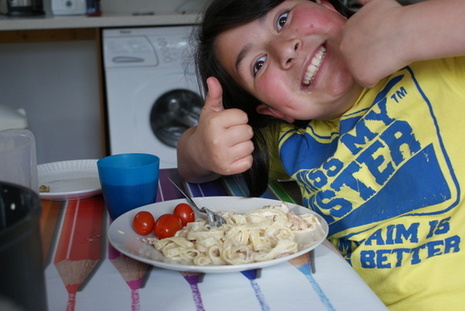
Serves 4
Ingredients
250g Tagliatelle (12 nests)
4 rashers (200g) thick-slice bacon
150g Philadelphia cream cheese
2 egg yolks
200ml boiling water with ½ chicken stock cube
3 cloves garlic
sun-dried tomatoes, sliced (for the sophisticated philistine)
Method
4 rashers (200g) thick-slice bacon
150g Philadelphia cream cheese
2 egg yolks
200ml boiling water with ½ chicken stock cube
3 cloves garlic
sun-dried tomatoes, sliced (for the sophisticated philistine)
Dissolve half a chicken (or vegetable) stock cube in 200ml boiling water.
Slice your bacon into bite-sized pieces
Peel and chop the garlic into chunks
Separate the eggs and blend the cream cheese with the yolks
Slice the sun-dried tomatoes if you're having them.
Boil a large pot of salted, oiled water for the pasta
Put the pasta in the boiling water and simmer until tender (8 minutes).
Meanwhile cook the bacon in a large oiled frying pan until starting to colour, add the garlic pieces, and fry until done. Set aside.
When the pasta is ready, strain it and set it on one side to drain.
Meanwhile return the pot to the hob and pour in the stock and add the bacon mixture.
Reheat, then add the pasta back in and stir through.
Finally, turn off the heat, add the cream cheese and egg yolk mixture, mix thoroughly and serve, dressed with side-salad, fresh tomatoes or anything else vaguely healthy that your children will contemplate eating for that warm five-a-day glow..
Add the sun-dried tomatoes, olives or anything else you fancy as a topping if you are adventurous!
Sit back and glory in the approval.
Slice your bacon into bite-sized pieces
Peel and chop the garlic into chunks
Separate the eggs and blend the cream cheese with the yolks
Slice the sun-dried tomatoes if you're having them.
Boil a large pot of salted, oiled water for the pasta
Put the pasta in the boiling water and simmer until tender (8 minutes).
Meanwhile cook the bacon in a large oiled frying pan until starting to colour, add the garlic pieces, and fry until done. Set aside.
When the pasta is ready, strain it and set it on one side to drain.
Meanwhile return the pot to the hob and pour in the stock and add the bacon mixture.
Reheat, then add the pasta back in and stir through.
Finally, turn off the heat, add the cream cheese and egg yolk mixture, mix thoroughly and serve, dressed with side-salad, fresh tomatoes or anything else vaguely healthy that your children will contemplate eating for that warm five-a-day glow..
Add the sun-dried tomatoes, olives or anything else you fancy as a topping if you are adventurous!
Sit back and glory in the approval.
Another Oxo triumph!
Warm the plates first if you want to avoid the worst of the congealing sauce issues.
Warm the plates first if you want to avoid the worst of the congealing sauce issues.
Baby's Got A Brand New Hob
In celebration of Rachel's Brand New Hob I made up a tasty Stir-Fry.
It's something everyone will eat, which is a bonus, particularly if you don't add any
- chillies
- ginger
- mushrooms
- sweetcorn
- celery
- cabbage
- sprouts
- fish
...
In the dark days before HOB we really had to rely on our wits for feeding the family, and our invention of the waffle cake or pwaffle dates from those early times.
- chillies
- ginger
- mushrooms
- sweetcorn
- celery
- cabbage
- sprouts
- fish
...
In the dark days before HOB we really had to rely on our wits for feeding the family, and our invention of the waffle cake or pwaffle dates from those early times.
Stir-Fried Pork and Vegetables
oriental main meat
Serves 6Ingredients
1 carrot, halved lengthways, sliced diagonally
1 courgette, halved lengthways, sliced diagonally
4 spring onions, sliced diagonally
½ head broccoli, stalks sliced, florets separated
3 cloves garlic, sliced
500g/1 lb pork tenderloin fillet
800g/2 lb Hokkien egg noodles
½ red pepper, sliced
8 asparagus spear tips, halved lengthways if thick, sliced diagonally
Marinade
1 tablespoon shao hsing wine
1 Tablespoon hoisin sauce
1 Tablespoon malt vinegar (which I completely forgot!)
1 Tablespoon white sugar
2 teaspoons light soy sauce
1 teaspoon sesame oil
Sauce
2 Tablespoons shao hsing wine
2 Tablespoon light soy sauce
juice 1 tangerine
3 teaspoons cornflour
Method
1 courgette, halved lengthways, sliced diagonally
4 spring onions, sliced diagonally
½ head broccoli, stalks sliced, florets separated
3 cloves garlic, sliced
500g/1 lb pork tenderloin fillet
800g/2 lb Hokkien egg noodles
½ red pepper, sliced
8 asparagus spear tips, halved lengthways if thick, sliced diagonally
Marinade
1 tablespoon shao hsing wine
1 Tablespoon hoisin sauce
1 Tablespoon malt vinegar (which I completely forgot!)
1 Tablespoon white sugar
2 teaspoons light soy sauce
1 teaspoon sesame oil
Sauce
2 Tablespoons shao hsing wine
2 Tablespoon light soy sauce
juice 1 tangerine
3 teaspoons cornflour
Slice the pork fillet lengthways once or twice depending on thickness, then cut into ¼" (5mm) slices.
Mix up the marinade and cover the pork slices. Set aside to marinate for 30 minutes.
Cut the vegetables into half lengthways (unless they are quite thin) and slice into nice diagonals, about the thickness of pound coins. Keep the asparagus tips and brocolli florets whole. Put each pile of sliced vegetables aside in separate bowls.
Drain the meat of marinade.
Heat the wok, add a splash of oil and fry the pork until browned and set aside. Do this in two batches if necessary to keep the wok hot. If you get a lot of water building up, scoop out the meat, pour the water off into the marinade, and start frying the meat again.
Mix together the left-over marinade and the sauce ingredients.
Keeping the wok hot, and adding oil as necessary, fry each of the vegetables, starting with those which will take the longest to cook. Set the vegetables aside in another large dish as the wok fills up and carry on frying.
When all the vegetables are done, clean out the pan, then re-fry the pork, then add the noodles and another generous splash of oil. Fry the noodles until warmed thoroughly, then add the sauce mixture. Stir the sauce through until it thickens around the noodles.
Either throw the vegetables back in and stir everything until well mixed and piping hot. Or tip the noodle mixture out into a serving dish, reheat the vegetables and pile them on top.
Serve.
Mix up the marinade and cover the pork slices. Set aside to marinate for 30 minutes.
Cut the vegetables into half lengthways (unless they are quite thin) and slice into nice diagonals, about the thickness of pound coins. Keep the asparagus tips and brocolli florets whole. Put each pile of sliced vegetables aside in separate bowls.
Drain the meat of marinade.
Heat the wok, add a splash of oil and fry the pork until browned and set aside. Do this in two batches if necessary to keep the wok hot. If you get a lot of water building up, scoop out the meat, pour the water off into the marinade, and start frying the meat again.
Mix together the left-over marinade and the sauce ingredients.
Keeping the wok hot, and adding oil as necessary, fry each of the vegetables, starting with those which will take the longest to cook. Set the vegetables aside in another large dish as the wok fills up and carry on frying.
When all the vegetables are done, clean out the pan, then re-fry the pork, then add the noodles and another generous splash of oil. Fry the noodles until warmed thoroughly, then add the sauce mixture. Stir the sauce through until it thickens around the noodles.
Either throw the vegetables back in and stir everything until well mixed and piping hot. Or tip the noodle mixture out into a serving dish, reheat the vegetables and pile them on top.
Serve.
If you wanted you could serve the noodles with the vegetables piled on top.
If you weren't cooking for wimps you would add chillies, ginger and probably a lot more salt to the sauce.
If you weren't cooking for wimps you would add chillies, ginger and probably a lot more salt to the sauce.
from those days before HOB
Pwaffles
breakfast veg
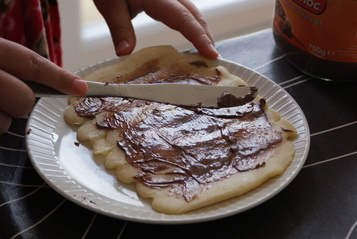

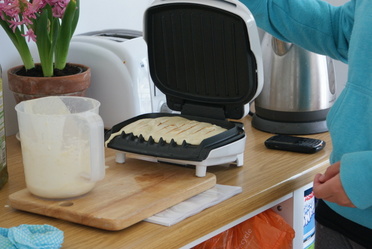
Want pancakes but have only a George Foreman mini-grill or a toasted sandwich maker?
Not a problem, just make up your pancake mix as normal, chock up the grill to make it level and prevent the batter from just running out all over the table and Hey Presto One Pwaffle Iron™!
Now just fire it up and your pwaffle will be ready just before you smell burning.
Decorate as for pancakes and enjoy!
Not a problem, just make up your pancake mix as normal, chock up the grill to make it level and prevent the batter from just running out all over the table and Hey Presto One Pwaffle Iron™!
Now just fire it up and your pwaffle will be ready just before you smell burning.
Decorate as for pancakes and enjoy!
Ingredients:
Dinner With Hussies
A lovely dinner with our friends the Hussies had two notable highlights - the Olive and Ricotta starter for me,
and the Tiramisu for Rachel. Perhaps the level of Amaretto content coloured her judgement.
Sorry no photos. Although I recently bought myself a cool second-hand digital SLR Sony Alpha 200 from ebay, I've only just started playing around with it, and to be honest I thought it might seem a little importunate pulling it out at a dinner party, enormous beast that it is.
Sorry no photos. Although I recently bought myself a cool second-hand digital SLR Sony Alpha 200 from ebay, I've only just started playing around with it, and to be honest I thought it might seem a little importunate pulling it out at a dinner party, enormous beast that it is.
Olive and Ricotta Pâté
starter cheese
Takes 40 minutes.
Serves 6
Ingredients
450g/1 lb ricotta cheese
50g/2 oz parmesan, finely grated
2 medium egg whites, lightly beaten
190g jar lemon and mint marinated green olives
185g can pitted black olives, drained
4 sun-dried tomatoes, roughly chopped
2 sprigs fresh rosemary, leaves only
bread and roasted whole vine tomatoes to serve
Method
50g/2 oz parmesan, finely grated
2 medium egg whites, lightly beaten
190g jar lemon and mint marinated green olives
185g can pitted black olives, drained
4 sun-dried tomatoes, roughly chopped
2 sprigs fresh rosemary, leaves only
bread and roasted whole vine tomatoes to serve
Preheat the oven to 200°C/Gas 6/fan oven 180°C.
Oil and base line a 20cm/8" sandwich tin.
In a large bowl, beat together the ricotta, parmesan, egg whites and seasoning.
Spoon into the prepared cake tin and level the surface with the back of a wet spoon. Press the olives, sun-dried tomatoes and rosemary into the surface and bake for 25-30 minutes until firm.
Turn out and remove the paper. Serve in wedges with bread and roasted tomatoes.
Spoon into the prepared cake tin and level the surface with the back of a wet spoon. Press the olives, sun-dried tomatoes and rosemary into the surface and bake for 25-30 minutes until firm.
Turn out and remove the paper. Serve in wedges with bread and roasted tomatoes.
A gorgeous, firm, quiche-like pâté,
with a deep rich flavour almost of goat's cheese.
You can serve it cold, with a small salad around the roast tomatoes, though I think it would go really well with a tomato sauce or oil.
To roast the tomatoes, you can place them whole on a non-stick backing tray, drizzle with olive oil and bake for 10 minutes in the 200°C oven or until they start to split or blister. They look nice with their stalks still in.
You can serve it cold, with a small salad around the roast tomatoes, though I think it would go really well with a tomato sauce or oil.
To roast the tomatoes, you can place them whole on a non-stick backing tray, drizzle with olive oil and bake for 10 minutes in the 200°C oven or until they start to split or blister. They look nice with their stalks still in.
Leftover Monday. And Tuesday. And Wednesday...
Leftovers. They're a blessing. And a curse.
After days of congealed béarnaise sauce-buttered Breakfast Bap sandwiches filled with leftover Roast beef, mayonnaise, dijon mustard, sliced red onion, tomato and rocket, I hit upon the Beef Wellingtonettes for using up the beef in a hurry.
Not only that, but I used up the spare mussels too. Hurray.
After days of congealed béarnaise sauce-buttered Breakfast Bap sandwiches filled with leftover Roast beef, mayonnaise, dijon mustard, sliced red onion, tomato and rocket, I hit upon the Beef Wellingtonettes for using up the beef in a hurry.
Not only that, but I used up the spare mussels too. Hurray.
Spare Mussel Tagliatelle
main pasta fish
Something to make after you've drunk a good steaming bowl of mussel stock
It helps if either you thoroughly de-beard the mussels whilst you're cleaning them by wiggling the beards back and forth until the pull cleanly out of the shell, or you remove the tangled seaweedy mass as you shuck the mussel shells after making the stock.
Mouthfulls of chewy mussel beard in your tagliatelle are just yeuch.
It helps if either you thoroughly de-beard the mussels whilst you're cleaning them by wiggling the beards back and forth until the pull cleanly out of the shell, or you remove the tangled seaweedy mass as you shuck the mussel shells after making the stock.
Mouthfulls of chewy mussel beard in your tagliatelle are just yeuch.
Serves 4
Ingredients
tagliatelle
olive oil
2 rashers smoked bacon. Probably not leftover. Unfortunately
24 leftover mussels, shucked and chilled
3 leftover shallots, minced
6 leftover garlic cloves, puréed
2-4 button mushrooms, roughly chopped
2 cups leftover double cream
leftover chilli parsley butter
Method
olive oil
2 rashers smoked bacon. Probably not leftover. Unfortunately
24 leftover mussels, shucked and chilled
3 leftover shallots, minced
6 leftover garlic cloves, puréed
2-4 button mushrooms, roughly chopped
2 cups leftover double cream
leftover chilli parsley butter
Put a pot of pasta water on to boil
Chop the bacon into relatively generous lardons. Fry in olive oil until cooked through, add the shallots and cook until soft, add the garlic and cook through, add the mushrooms (not too finely chopped) and warm through then add the cream.
Start the tagliatelle cooking
Now when the cream mixture has heated through, add the mussels, reheat then add the chilli parsley butter in small quantities and whisk in to thicken the sauce.
Season.
Drain the pasta and serve topped with the mussel sauce
Chop the bacon into relatively generous lardons. Fry in olive oil until cooked through, add the shallots and cook until soft, add the garlic and cook through, add the mushrooms (not too finely chopped) and warm through then add the cream.
Start the tagliatelle cooking
Now when the cream mixture has heated through, add the mussels, reheat then add the chilli parsley butter in small quantities and whisk in to thicken the sauce.
Season.
Drain the pasta and serve topped with the mussel sauce
It's pretty tasty, though the sauce could be thicker - maybe some flour cooked in before the shallots?
Beef Wellingtonettes
main meat
Yum. Dig that leftover beef.
It's ok to use shop-bought puff pastry sheets: It's leftovers.
It's ok to use shop-bought puff pastry sheets: It's leftovers.
Ingredients
fist-sized chunks of leftover roast beef
puff pastry
6 button mushrooms
leftover shallots and garlic (optional)
dijon mustard
Method
puff pastry
6 button mushrooms
leftover shallots and garlic (optional)
dijon mustard
Preheat the oven to 200°C/gas 6.
Blend the mushrooms to a paste in a food processor. Add a little shallot or garlic if you like On second thoughts, maybe not the shallots. You could add truffle or fois gras though, if you're feeling rich
Fry in a little butter until slightly reduced and the mushrooms will hold together.
Smear the steak chunks with mustard (or horseradish), then cover with the mushrooms and roll in the puff pastry.
Bake in the oven for 20 minutes until golden brown.
(though not too close together lest they merge into one big soggy Wellingtonboot, and the girlies pick at them listlessly complaining that they aren't properly cooked)
Eat with the leftover Sambuca mushrooms and Green Beans.
Blend the mushrooms to a paste in a food processor. Add a little shallot or garlic if you like On second thoughts, maybe not the shallots. You could add truffle or fois gras though, if you're feeling rich
Fry in a little butter until slightly reduced and the mushrooms will hold together.
Smear the steak chunks with mustard (or horseradish), then cover with the mushrooms and roll in the puff pastry.
Bake in the oven for 20 minutes until golden brown.
(though not too close together lest they merge into one big soggy Wellingtonboot, and the girlies pick at them listlessly complaining that they aren't properly cooked)
Eat with the leftover Sambuca mushrooms and Green Beans.
John's Massive Burgers
The first time Rachel and I met John socially was at a charity rubber duck race,
where he was running a burger stall.
As I recall, the burgers were rather nice, though obviously I was seriously distracted by all the rubber ducks swimming around unsupervised.
Little tarts.
Today he told me all about the rather nice burger he'd knocked up for dinner, and since the horseradish sounded interesting I thought I'd write it up, together with the stew he made the weekend before.
Little tarts.
Today he told me all about the rather nice burger he'd knocked up for dinner, and since the horseradish sounded interesting I thought I'd write it up, together with the stew he made the weekend before.
Breaking news:
It turns out that John confused horseradish with plain old radish.
Which doesn't sound quite so attractive.
It turns out that John confused horseradish with plain old radish.
Which doesn't sound quite so attractive.
John's Massive Burgers
main snack meat
Serves One Massive Burger EaterIngredients
mince
tomato purée
grated horseradish (!)
a massive fluffy white bun
a slice of Jarlsberg
Method
tomato purée
grated horseradish (!)
a massive fluffy white bun
a slice of Jarlsberg
John's Beef Stew
main meat stew
This recipe is written as dictated, so you will have to forgive the colloquialisms - the poor boy is a local you know.
Ingredients
some nice cubed stewing steak - big thick bits
carrots
baby pearl potatoes
loads of onions (two of the buggers)
wee bit of garlic (natch)
wee spot of Dijon mustard
a handful of wee button mushrooms
a wee touch of paprika for colouring
Method
carrots
baby pearl potatoes
loads of onions (two of the buggers)
wee bit of garlic (natch)
wee spot of Dijon mustard
a handful of wee button mushrooms
a wee touch of paprika for colouring
Brown the steak (with no flour) - adding a wee spot of mustard and just two cloves of garlic,
crushed and wheeched back out - really just to flavour the oil a little.
Cut one of the onions in quarters, and the other very finely chopped to thicken the stew. Soften the chopped onion.
Add some beef shin stock, a dash of Chilean Merlot, paprika, mushrooms, onion quarters and the vegetables.
John also threw in some shitake mushrooms but noted that he thought you should use a bit less of the shitake - they didn't work too well as I only have them dried. I rehydrated them in on their own in the stock while I was bringing it up to temperature.
And that was really about it - except I put a couple of dumpling in in the last twenty minutes. Just suet and water, nothing clever. Not that much flour - about 30/70, and a wee bit black pepper.
Cut one of the onions in quarters, and the other very finely chopped to thicken the stew. Soften the chopped onion.
Add some beef shin stock, a dash of Chilean Merlot, paprika, mushrooms, onion quarters and the vegetables.
John also threw in some shitake mushrooms but noted that he thought you should use a bit less of the shitake - they didn't work too well as I only have them dried. I rehydrated them in on their own in the stock while I was bringing it up to temperature.
And that was really about it - except I put a couple of dumpling in in the last twenty minutes. Just suet and water, nothing clever. Not that much flour - about 30/70, and a wee bit black pepper.
John's Pulled Pork Rub
ingredient meat crockpot
John loves to pull his pork. Aye, and here's the rub...
Ingredients
- 5 tbsp smoked hot paprika
- 3 tbsp sea salt flakes
- 2 tbsp cayenne pepper
- 2 tbsp ground cumin
- 2 tbsp ground black pepper
- 2 tbsp ground fennel seeds
- 2 tbsp ground coriander
- 2 tbsp dry mustard powder
Rub pork.
Cook in slow cooker until meat falls apart at the slightest touch.
Eat.
Cook in slow cooker until meat falls apart at the slightest touch.
Eat.
John's Tooth-Achingly Tasty Dessert
sweet veg
John also likes his sweet desserts. Now did he say it was tooth-achingly tasty, or just tooth-aching?
Ingredients
- salted peanuts
- caramel
- fudge
In a baking tray spread a double layer of salted peanuts, followed by a pouring of caramel and a chill in the fridge.
Then make fudge, let it cool and roll it out to the shape of the tray and lay over the caramel.
Roll up with the peanuts outwards.
Slice and eat.
Then make fudge, let it cool and roll it out to the shape of the tray and lay over the caramel.
Roll up with the peanuts outwards.
Slice and eat.
Just about my favourite breakfast. Providing it's washed down by a Bloody good Mary of course.
By way of comforting myself whilst Rachel and I are on our spring breakup (sigh!), I treated myself to my first attempt to make Eggs Benedict from the muffin up. Well, except for curing the ham and laying the eggs of course.
I chose a muffin recipe that uses yoghurt in with the water, which seemed to work perfectly well, Paul Gayler's workmanlike version of Hollandaise sauce, and crispy grilled Parma ham.
Being temporarily unencumbered by a car, I did all my shopping on Sunday at the local Asda, so was extremely limited as to the quality of ingredients. Although I was able to find some pre-packed super-thinly sliced Parma ham, I had to make do with their standard Sad Chicken brand of old eggs. I no more believe that their chickens are organic and free-ranging than I believe their pork products are naturally puce. More surprisingly, it was impossible to find semolina to dust the muffins, because their baking section is ludicrously small and ineptly disorganised over several unrelated aisles. This is either because Asda do not want their customers baking their own products, lest they discover how anaemic are the in-store goods on offer, or because Asda shoppers have lost their capacity to cook flour.
And the result?
A bit disappointing to be honest - I won't be giving those restaurant breakfasts a run for their money just yet.
I couldn't fault the muffins (misshapen and semolina-free as they were), but my Hollandaise was far too tart (Note To Self: Add the lemon juice cautiously and taste the sauce as you go) and the ham was just wrong.
Difficult to say quite why it was so wrong - perhaps it would have worked better if I hadn't grilled it and just laid it on raw, but somehow my mouth was expecting a thick juicy slice of "Canadian" smoked bacon, and what it got was a thin crispy layer of dry-cured Italian lard. Just plain wrong!
Also it's probably a good job I was only cooking for one, because turning out individually poached eggs is a painfully slow process. I do need to figure out a faster serving method for more customers.
Oh, and I didn't have any bloody Bloody Marys
By way of comforting myself whilst Rachel and I are on our spring breakup (sigh!), I treated myself to my first attempt to make Eggs Benedict from the muffin up. Well, except for curing the ham and laying the eggs of course.
I chose a muffin recipe that uses yoghurt in with the water, which seemed to work perfectly well, Paul Gayler's workmanlike version of Hollandaise sauce, and crispy grilled Parma ham.
Being temporarily unencumbered by a car, I did all my shopping on Sunday at the local Asda, so was extremely limited as to the quality of ingredients. Although I was able to find some pre-packed super-thinly sliced Parma ham, I had to make do with their standard Sad Chicken brand of old eggs. I no more believe that their chickens are organic and free-ranging than I believe their pork products are naturally puce. More surprisingly, it was impossible to find semolina to dust the muffins, because their baking section is ludicrously small and ineptly disorganised over several unrelated aisles. This is either because Asda do not want their customers baking their own products, lest they discover how anaemic are the in-store goods on offer, or because Asda shoppers have lost their capacity to cook flour.
And the result?
A bit disappointing to be honest - I won't be giving those restaurant breakfasts a run for their money just yet.
I couldn't fault the muffins (misshapen and semolina-free as they were), but my Hollandaise was far too tart (Note To Self: Add the lemon juice cautiously and taste the sauce as you go) and the ham was just wrong.
Difficult to say quite why it was so wrong - perhaps it would have worked better if I hadn't grilled it and just laid it on raw, but somehow my mouth was expecting a thick juicy slice of "Canadian" smoked bacon, and what it got was a thin crispy layer of dry-cured Italian lard. Just plain wrong!
Also it's probably a good job I was only cooking for one, because turning out individually poached eggs is a painfully slow process. I do need to figure out a faster serving method for more customers.
Oh, and I didn't have any bloody Bloody Marys
Fish Soup. Or Stew. You choose.
Another Fabulous Failure.
This started as out as an inventive way to use up the enormous sack of (very large pieces of) dessicated coconut that we have cluttering up the kitchen, and all the bits of leftover vegetables from the bottom of the fridge.
But it started to go wrong in the supermarket when Rachel suggested that fish might be acceptable since Georgina had now started trying new things and would no longer only eat super noodles with ketchup on. I suppose I should have expected problems when the smell of my hot fish sauce dressing made everyone gip and completely ban it from the dining room. Even Rachel refused to have it anywhere near her bowl.
Georgina flatly refused to touch the soup.
"I won't eat fish" she said.
"I hate fish" she said.
"I hate the smell of fish" she said.
"You know I hate fish" she said.
"Why do you keep giving me fish" she asked.
"I even tried the Haggis, and I hate haggis" she said.
"I'm never going to eat fish" she said.
"Never".
To cap it all off, even Sophie turned up her nose at it. And she likes fish. But apparently not the tomatoes or the mushrooms or the slop.
"It didn't really taste of anything, it was too lumpy and I didn't like all the UFO's in it" she said.
"The Unidentified Floating Objects" she said.
Bloody Philistines! I thought it was delicious.
This started as out as an inventive way to use up the enormous sack of (very large pieces of) dessicated coconut that we have cluttering up the kitchen, and all the bits of leftover vegetables from the bottom of the fridge.
But it started to go wrong in the supermarket when Rachel suggested that fish might be acceptable since Georgina had now started trying new things and would no longer only eat super noodles with ketchup on. I suppose I should have expected problems when the smell of my hot fish sauce dressing made everyone gip and completely ban it from the dining room. Even Rachel refused to have it anywhere near her bowl.
Georgina flatly refused to touch the soup.
"I won't eat fish" she said.
"I hate fish" she said.
"I hate the smell of fish" she said.
"You know I hate fish" she said.
"Why do you keep giving me fish" she asked.
"I even tried the Haggis, and I hate haggis" she said.
"I'm never going to eat fish" she said.
"Never".
To cap it all off, even Sophie turned up her nose at it. And she likes fish. But apparently not the tomatoes or the mushrooms or the slop.
"It didn't really taste of anything, it was too lumpy and I didn't like all the UFO's in it" she said.
"The Unidentified Floating Objects" she said.
Bloody Philistines! I thought it was delicious.
Fish soup
soup fish
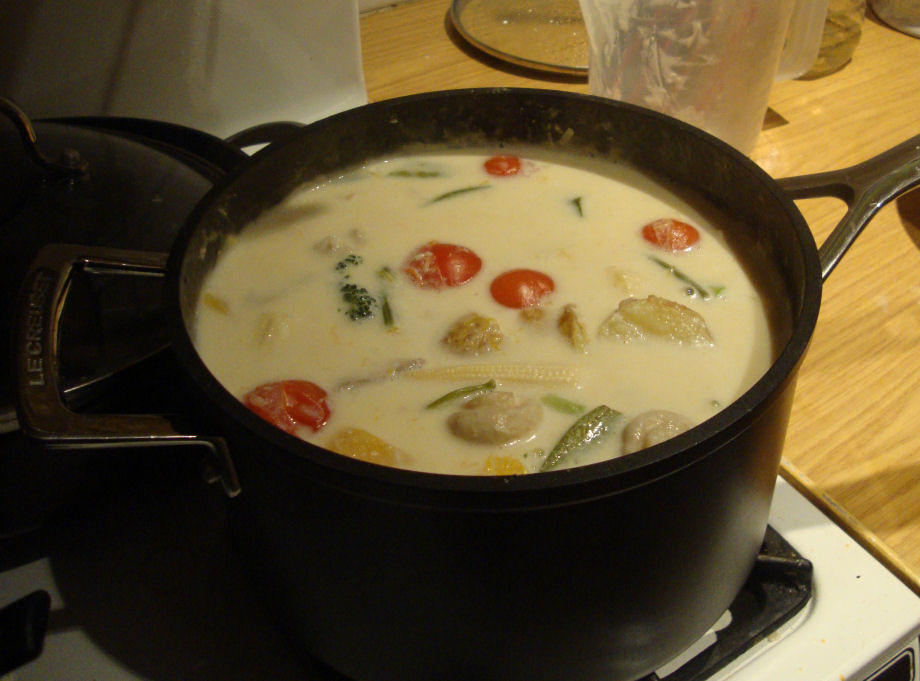
Ingredients
1lb cod, haddock or coley, skinned and de-boned
12 new potatoes
1 small butternut squash
2 rounded Tablespoons flour.
2 pints milk, or as necessary
6 garlic cloves, pressed
1 large onion, diced
1 cup dessicated coconut. Soaked if you have the time.
mangetout
baby sweetcorn
cherry tomatoes
broccoli
courgette
carton button mushrooms
salt
fishy dressing
2" ginger, finely grated or julienned.
2 Tablespoons fish sauce.
juice of 1 lime
Method
12 new potatoes
1 small butternut squash
2 rounded Tablespoons flour.
2 pints milk, or as necessary
6 garlic cloves, pressed
1 large onion, diced
1 cup dessicated coconut. Soaked if you have the time.
mangetout
baby sweetcorn
cherry tomatoes
broccoli
courgette
carton button mushrooms
salt
fishy dressing
2" ginger, finely grated or julienned.
2 Tablespoons fish sauce.
juice of 1 lime
Start the potatoes boiling in a large pot of water to soften them. No need to scrub or peel them, the pre-boil will take care of that.
Fry the flour in butter until cooked through, but not darkened. Add the garlic then the onions and the dessicated coconut. Fry until the onions soften, but don't brown them.
Clean the mushrooms, cut up any larger ones and add to the sauce.
Cut the baby sweetcorn into nice bite-sized chunks diagonally and add to the pot.
Cut the mangetout diagonally into halfs or bit-sized slices and add to the pot.
Peel the butternut squash, cut into slices, deseed and cut into bite-sized pieces. Add to the pot.
Cut the courgette into bite-sized chunks and add to the pot.
Break the broccoli into florets and add to the pot
Cut the fish into bite-sized chunks and add to the pot
Add the cherry tomatoes to the pot and simmer for another 10-15 minutes until the fish is cooked through and the tomatoes are soft, but not popped.
Meanwhile make the dressing. Fry the ginger in a little vegetable oil until it begins to crisp and brown, then throw in the fish sauce and the lime juice. you might have to do this outside if you don't want to get the dressing banished forever, the smell is a little overpowering
If you have grated the ginger you will need to strain this dressing, if julienned you might be able to leave the ginger in.
Ladle the soup into bowls. Drizzle with a little dressing and serve.
Fry the flour in butter until cooked through, but not darkened. Add the garlic then the onions and the dessicated coconut. Fry until the onions soften, but don't brown them.
I fried the onions and coconut in butter separately, but I don't see why you couldn't do this all together.
Gradually add the milk, whisking constantly to make up a thin roux of sufficient quantity.
(set aside some of the mixture whilst continuing to dilute if it seems to be going to be too thick).
Purée thoroughly in a blender then season, pour into a large pan and bring to a gentle simmer.
If you weren't cooking for philistines you might forget about blending the onion and chop it into reasonably chunky
pieces to fry separately and add to the roux now. I think it makes quite a nice thickener though.
Add the pre-cooked potatoes to the roux.Clean the mushrooms, cut up any larger ones and add to the sauce.
Cut the baby sweetcorn into nice bite-sized chunks diagonally and add to the pot.
Cut the mangetout diagonally into halfs or bit-sized slices and add to the pot.
Peel the butternut squash, cut into slices, deseed and cut into bite-sized pieces. Add to the pot.
Cut the courgette into bite-sized chunks and add to the pot.
Break the broccoli into florets and add to the pot
Cut the fish into bite-sized chunks and add to the pot
Add the cherry tomatoes to the pot and simmer for another 10-15 minutes until the fish is cooked through and the tomatoes are soft, but not popped.
Meanwhile make the dressing. Fry the ginger in a little vegetable oil until it begins to crisp and brown, then throw in the fish sauce and the lime juice. you might have to do this outside if you don't want to get the dressing banished forever, the smell is a little overpowering
If you have grated the ginger you will need to strain this dressing, if julienned you might be able to leave the ginger in.
Ladle the soup into bowls. Drizzle with a little dressing and serve.
Delicious. I thought. The dressing cuts the slightly cloying thickness of the soup.
Obviously if you weren't trying to make it acceptable to small tummies you could spice it up Thai styley.
If you prepare and add the ingredients in the right order they will all be perfectly cooked at serving time.
Obviously if you weren't trying to make it acceptable to small tummies you could spice it up Thai styley.
If you prepare and add the ingredients in the right order they will all be perfectly cooked at serving time.
